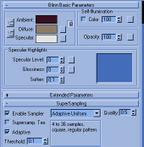 |
|||||||||
|
|
||||||||||||||||||
|
|
| Want to leave us a comment about the site or in general? Click here to access the form. |
 |
|
CEL Shader: Chapter 2 by: Allan McKay Added on: Tue Dec 19 2000 |
|
| Page: 1 2 3 | |
In my previous article I went into the extreme basics on how to make a basic cel shader, I figure in my spare time I'll try to go a bit more in depth on how to make a more effective shader.  For this tutorial you'll need shadow/light and side fade both from Blur Studios. To start off load up max and create a teapot, good ol' teapot... Load up the material editor and click on the get button  Now what we want to do is adjust the following settings, make the ambient colour a dark brown, the diffuse colour a lighter brown and white bright white (these will be the basic colours of our ink outlines). Adjust the shinyness and other specular values to 0 so there's no shinyness, also set the self illumination to be 100. So basically we've just set the colour of the material to be light brown without any shinyness values, and 100% self illuminated so lights don't really effect it (if we have self illumination off it doesn't look very 2D'ish). Now expand the super sampling rollout and enable it first of all, adjust the sampling method to adaptive uniform and make sure adaptive is ticked with a threshhold value of .1 and quality .5.   |
Best viewed in 1024x768 or higher,
using any modern CSS compliant browser.